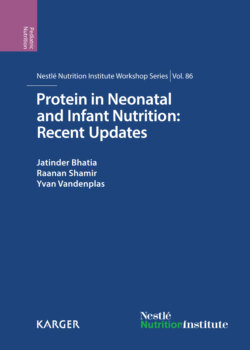Читать книгу Protein in Neonatal and Infant Nutrition: Recent Updates - Группа авторов - Страница 36
На сайте Литреса книга снята с продажи.
Extensively Hydrolyzed Formulas
ОглавлениеCM-derived eHF is the preferred treatment option in infants with CMA who are not breastfed except in the ones who refuse or do not tolerate eHF or in the most severe cases, in which AAF should be started. The majority of infants and children with CMA tolerate an eHF with whey or Cas as a nitrogen source [1]. According to the literature, a few (severe) allergic infants (2-10%) might still react to eHF-C and eHF-W [1-3, 17]. The choice of the eHF should be based on the efficacy demonstrated by scientific studies [1].
Two recent trials with a new eHF-C [43] and a new eHF-W [44] in infants with mild-to-moderate CMA showed that all confirmed CMA cases tolerated the formulas tested [1]. A symptom-based score decreased significantly in all infants within 1 month [43, 44], and the highest reduction occurred in those with challenge-confirmed CMA [43]. The thickened version of the eHF-C produced also a reduction in regurgitation in infants with positive or negative challenge [43].
HFs may indeed improve reflux-related and digestive symptoms not only by an immune mechanism but also by acting on gastric emptying time. A double-blind, randomized, crossover study compared gastric emptying in 20 healthy newborns fed CM-SF, pHF and eHF containing 50 ml 13C-octanoic acid. eHF resulted in significantly faster gastric emptying than SF and pHF (medians 46 vs. 55 and 53 min, respectively) [45].
There is limited evidence that the addition of pre- or probiotics (e.g. Lactobacillus rhamnosus GG, LGG, or Bifidobacterium lactis) to eHF offer an additional benefit [46, 47].
A cohort study in 412 infants with CMA with data extracted from the Truven Health MarketScan® Commercial Claims Database in the US showed that 56% of infants fed eHF-C enriched with the probiotic LGG were estimated to have been successfully managed by 9 months compared to 38% of eHF-C-fed infants and 35% of AAF-fed infants (p < 0.05 and p = 0.003, respectively) [48]. Infants in the AAF group used significantly more health care resources and prescribed drugs than infants in the other two groups. The estimated costs of managing a CMA infant over the first 12 months following the start of feeding were USD 3,577, 3,781 and 6,255 for an infant fed eHF-C plus LGG, eHF-C only and AAF, respectively [48].
